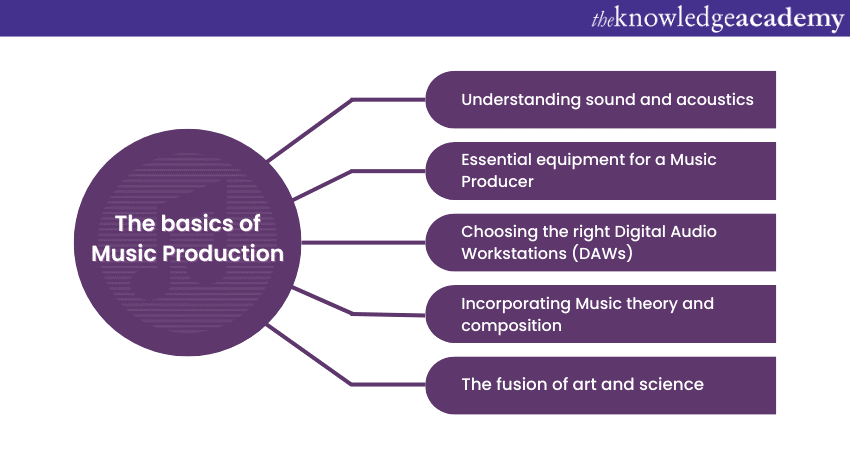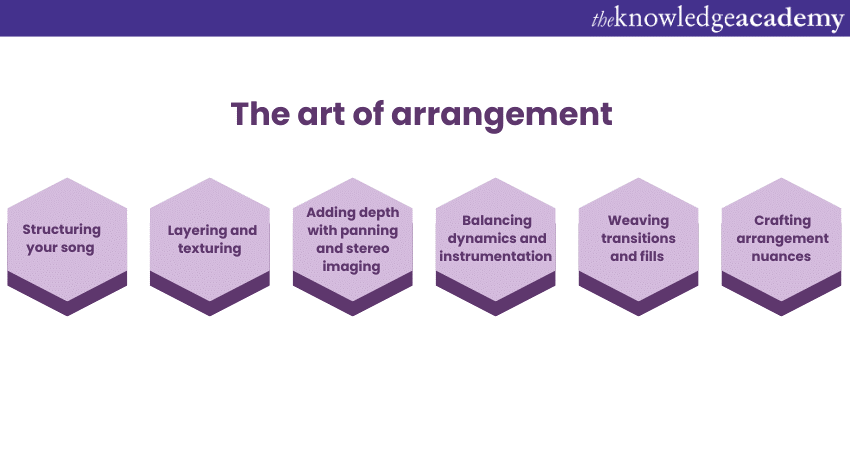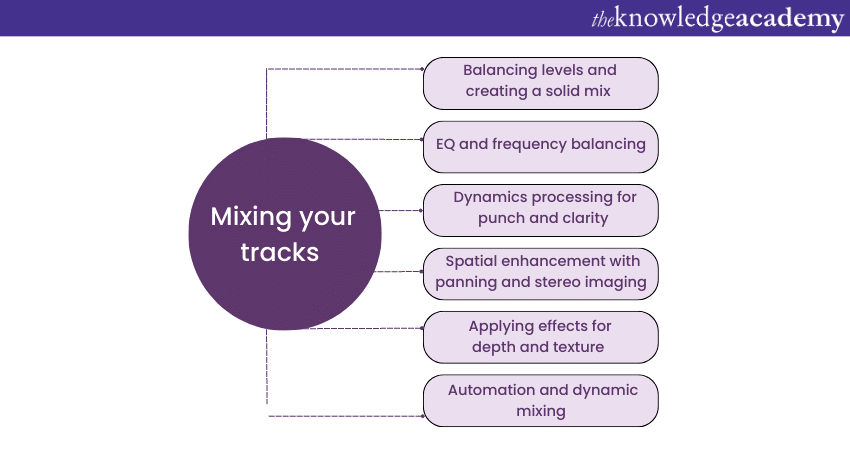We may not have the course you’re looking for. If you enquire or give us a call on 01344203999 and speak to our training experts, we may still be able to help with your training requirements.
Training Outcomes Within Your Budget!
We ensure quality, budget-alignment, and timely delivery by our expert instructors.

Music Production is an intricate tapestry woven from the threads of creativity, technology, and artistry. As we explore "Music Production: A Complete Journey," we dive into the heart of a discipline that shapes the fabric of our auditory experiences. At its core, Music Production is a harmonious blend of the artistic and the technical, where imagination dances with engineering to birth melodies that resonate with the soul.
It's the alchemical process of transforming ideas into tangible sonic realities, a journey that invites us to traverse the realms of inspiration, composition, arrangement, recording, and beyond. Music Production stands as a cornerstone in the modern music industry, where innovation is the compass guiding the way. From the intimacy of a singer's whispered confession to the grandeur of an orchestral symphony, every genre and style is nurtured within the embrace of skilled producers.
These unsung maestros wield microphones like brushes, DAWs like canvases, and mixing consoles like sculptor's tools. This blog will explore “What is Music Production”, uncovering the secrets of sound, unlocking the power of tools, and embracing the ever-present dance between innovation and tradition.
Table of Contents
1) The Basics of Music Production
2) Pre-production phase
3) Recording techniques
4) The art of arrangement
5) Music editing and post-production
6) Mixing your tracks
7) The final touch: Mastering
8) Music Production in the digital age
9) Conclusion
The basics of Music Production
At the crossroads of creativity and technology, the world of Music Production beckons aspiring creators to embark on a journey that transforms mere musical ideas into fully realised sonic masterpieces. As we venture into the foundational aspects of Music Production, we unearth the essential elements that underpin this art form.

Understanding sound and acoustics
Before we delve into the mechanics of production, it's crucial to grasp the fundamental nature of sound and its behaviour. Sound waves, frequencies, and the interplay of vibrations form the building blocks of music. Acoustics, the study of sound behaviour in different spaces, lends insight into crafting environments that enhance audio quality. Understanding sound propagation and reflection empowers producers to create captivating auditory experiences.
Essential equipment for a Music Producer
A music producer's toolkit is a symphony of technology and innovation. Microphones capture the nuances of vocal expressions and instrumental timbres, while audio interfaces bridge the gap between analogue and digital realms. Studio monitors and headphones provide accurate audio representation, while MIDI controllers facilitate virtual instrument manipulation. Equally important are acoustic treatments that tame reflections and resonances, fostering an optimal listening environment.
Digital Audio Workstations (DAWs): Choosing the right one
The central hub of a producer's domain is the Digital Audio Workstation (DAW). These software platforms serve as creative canvases, enabling artists to arrange, record, edit, mix, and master compositions. DAWs come in various flavours, each with its unique interface, features, and workflows. From industry giants like Pro Tools to versatile options like Ableton Live and Logic Pro, selecting the right DAW aligns with your musical style and production preferences.
Incorporating Music theory and composition
Beyond technology, Music Production draws heavily from music theory and composition principles. Knowledge of scales, chords, and harmonic progressions empowers producers to craft compelling melodies and harmonies. Composition techniques such as modulation, counterpoint, and thematic development infuse depth into musical arrangements, enriching the sonic narrative.
The fusion of art and science
In the world of Music Production, artistic vision and technical precision intertwine. Producers wear the hats of composers, engineers, and arrangers, channelling creativity through a spectrum of technical tools. This delicate balance between artistic intuition and scientific understanding allows producers to sculpt soundscapes that resonate with audiences.
Learn the characteristics of sound and periodic waveform types, sign up for our Music Production Masterclass Training now!
Pre-production phase
Before the first note is played or the initial button is clicked in a Digital Audio Workstation (DAW), the pre-production phase lays the essential groundwork for a successful Music Production journey. Creativity meets planning in this stage, and concepts transform into concrete visions.
Finding inspiration and setting goals
Every musical journey begins with a spark of inspiration. Inspiration fuels the creative process, whether it's a personal experience, a social issue, or a fleeting emotion. During this phase, artists and producers introspect, explore their influences, and pinpoint the core emotion they wish to convey. Once the creative compass is set, clear goals are established. These goals act as guiding stars, steering the project towards its intended destination.
Songwriting and composition
The heartbeat of any musical endeavour is its songwriting and composition. Here, melodies are born, lyrics take shape, and musical structures emerge. Songwriters craft narratives, exploring themes and storytelling techniques. Composers delve into the harmonic and melodic landscape, shaping the tonal palette that underpins the composition. This stage isn't just about notes; it's about evoking emotions and communicating messages through the language of music.
Preparing for the recording process
As the pre-production phase unfolds, practical considerations take centre stage. Choices regarding instrumentation, arrangement, and even tempo impact the overall sound and feel of the production. Producers collaborate with songwriters and composers to refine these elements, ensuring they align with the project's overarching vision. Additionally, this is when decisions about the choice of the recording studio, session musicians, and technical requirements are made, setting the stage for the recording process.
Storyboarding and visualising
Visualising the music's journey is a powerful pre-production tool. Much like a film's storyboard, producers create mental or physical outlines of the song's structure, identifying where verses, choruses, bridges, and instrumental breaks will reside. This process aids in pacing, transitions, and maintaining a cohesive narrative flow throughout the track.
Constructing demos
The pre-production phase often involves creating preliminary demos. These rough sketches of the song allow collaborators to hear the potential direction and make adjustments before diving into full-scale production. Demos can be as simple as a voice memo or a basic piano recording, providing a tangible preview of the song's essence.
Learn how to play guitar to create attractive music, sign up for our Guitar Masterclass now!
Recording techniques
In the recording phase, musical ideas and compositions emerge, transforming from abstract concepts to tangible sonic realities. This pivotal stage in the Music Production process requires a keen understanding of technical nuances and artistic expression as producers capture the essence of performance and weave it into the fabric of the final production.
Microphone selection and placement
Selecting the right microphone for each instrument and vocal is akin to choosing the right brush for a painter's canvas. Different microphones have unique tonal characteristics that can accentuate or tame specific frequencies. Condenser mics capture nuances and details, while dynamic mics offer durability and handling versatility. Ribbon mics add vintage warmth. Proper microphone placement is crucial; finding the "sweet spot" captures the instrument's timbre while minimising unwanted noise and reflections.
Tracking Instruments and vocals
Tracking involves the actual recording of individual instruments and vocal performances. Each element contributes to the sonic tapestry, and careful attention must be paid to capturing the essence of each performance. Whether recording drums, guitars, keyboards, or vocals, producers work to maintain the authenticity of the musician's style while adhering to the project's overarching vision.
Creating a quality recording environment
The recording environment plays a pivotal role in the quality of the recorded sound. Acoustic treatment, soundproofing, and ambient noise control are paramount to ensuring clean recordings. A well-treated room minimises unwanted reflections, resonances, and outside noises, allowing the captured sound to be as pure and unaltered as possible.
Capturing emotional performance
Beyond the technical aspects, recording is about capturing the emotional intensity of a performance. Producers work closely with musicians, ensuring they feel comfortable and inspired to deliver their best. A well-crafted atmosphere, often involving dimmed lights, a cosy ambience, and respectful communication, can help artists immerse themselves in the music, resulting in authentic and moving performances.
Multitrack recording and overdubbing
Multitrack recording involves capturing individual instruments and vocals on separate tracks. This technique offers flexibility during the editing and mixing stages, allowing for precise adjustments to each element's balance and effects. Overdubbing is recording additional layers on top of an existing track, enhancing depth and texture. It's a way to build complexity and create a richer musical palette.
Learn piano technique and perfect key methods of a piano, sign up for our Piano Masterclass now!
The art of arrangement
The arrangement phase in Music Production is akin to assembling a puzzle, where the individual pieces – melodies, harmonies, rhythms, and textures – are meticulously positioned to create a cohesive and captivating sonic experience. This phase is where the initial ideas and recordings begin to take on their final form, shaping the emotional narrative of the music.

Structuring your song
Arranging a song involves making deliberate choices about its structure. The arrangement dictates how the various sections – verses, choruses, bridges, and more – flow together to tell a compelling story. Effective arrangements build tension and release, guiding listeners through moments of anticipation and satisfaction. Producers strategically place these sections, creating a dynamic and engaging trajectory for the listener.
Layering and texturing
Layering is the art of combining multiple instruments and sounds to make a rich and textured musical piece. Each layer contributes a distinct colour to the sonic palette. From the foundational rhythm section to the melodic leads and harmonies, thoughtful layering brings depth and complexity to the arrangement. The interplay of different elements enhances the music's emotional impact and maintains listener engagement.
Adding depth with panning and stereo imaging
Panning and stereo imaging significantly influence the arrangement's spatial dimension. Producers use panning to position sounds across the stereo field, creating a sense of space and movement. Instruments can be placed left, right, centre, or anywhere between, allowing for a 3D-like auditory experience. This spatial manipulation adds an immersive quality to the arrangement, immersing listeners in the music.
Balancing dynamics and instrumentation
Arrangement is a balancing act between dynamics and instrumentation. Varying the intensity and volume of different sections keeps the arrangement dynamic and prevents listener fatigue. Instrumentation choices also contribute to the overall sonic balance. Producers must decide which instruments lead in different sections, ensuring no element competes for dominance.
Weaving transitions and fills
Transitions are the bridges that connect various sections, and well-crafted transitions maintain the song's momentum. Fills, such as drum rolls or instrumental flourishes, act as punctuation marks, emphasising key moments. Seamless transitions and clever fills enhance the arrangement's cohesiveness and overall musical experience.
Crafting arrangement nuances
The arrangement is not just about big structural decisions but also subtle nuances. These could include adding intricacies like background vocals, counter-melodies, or unexpected instrumental touches. These nuances add layers of interest that reward attentive listeners with discoveries upon repeated listening.
Music editing and post-production
The music editing and post-production phase is where the raw recordings are sculpted into polished gems. This meticulous process involves refining performances, correcting imperfections, and applying a range of creative and corrective techniques to elevate the sonic quality of the music.
Cleaning Up Recordings: editing and compiling
Editing is refining individual recordings to achieve a seamless and polished result. Producers trim unwanted noises, breaths, and pauses, ensuring a smooth flow. They also compile the best takes from multiple recordings to create a cohesive performance. This attention to detail transforms a collection of takes into a unified musical expression.
Quantisation and timing correction
Timing precision is essential in Music Production, and quantisation is a technique that aligns notes and beats to a grid. Producers use this to tighten rhythmic performances, ensuring a steady and groovy feel. Similarly, timing correction tools can be applied to vocal or instrumental performances to correct slight deviations without compromising the natural feel.
Adding effects: EQ, compression, reverb, and more
Effects play a pivotal role in shaping the character of a recording. Equalisation (EQ) balances frequencies, enhancing clarity and warmth. Compression controls dynamics, adding punch and cohesion to performances. Reverb and other spatial effects place sounds within virtual environments, adding depth and dimension. Producers deftly apply these effects to achieve the desired sonic landscape.
Pitch correction and vocal enhancement
Pitch correction tools are often used to refine vocal performances, ensuring accurate pitch without sounding robotic. Producers strike a balance between correcting off-key notes while maintaining the natural timbre and emotion of the vocalist. Vocal enhancement techniques like doubling, harmonies, and creative effects further elevate the vocal presence in the mix.
Compiling and arrangement tweaks
Post-production involves evaluating the arrangement's impact as a whole. Producers fine-tune the arrangement's dynamics, ensuring the emotional journey aligns with the intended experience. This might involve adjusting volume levels, fine-tuning transitions, or even rethinking the arrangement to optimise its impact.
Creating radio edits and alternate versions
For commercial viability, producers often create radio-friendly versions of tracks with adjusted lengths and arrangements. Alternate versions like instrumental mixes or remixes cater to diverse audience preferences. Each version retains its essence while offering a fresh perspective on the music.
Mixing your tracks
The mixing phase is where the individual elements of a recording converge, intertwining to create a harmonious sonic tapestry. This intricate process involves balancing, shaping, and sculpting the various tracks to achieve a cohesive, polished sound that captivates listeners.

Balancing levels and creating a solid mix
Balance is the foundation of a well-mixed track. Producers meticulously adjust the volume levels of each instrument and vocal, ensuring every element is clear and clear in the mix. Achieving a solid mix involves crafting a sonic landscape where every instrument and vocal has its place, contributing to the overall musical narrative.
EQ and frequency balancing
Equalisation (EQ) is a cornerstone of mixing. Producers use EQ to shape the tonal characteristics of individual tracks, carving out space for each element in the frequency spectrum. This technique prevents frequency clashes, allowing each instrument to shine without muddying the mix. Producers sculpt a balanced and pleasing sonic palette by accentuating desired frequencies and attenuating unwanted ones.
Dynamics processing for punch and clarity
Dynamics processing, which includes techniques like compression and limiting, adds polish and impact to a mix. The dynamic range of a track is controlled by compression, taming loud peaks and boosting softer elements, resulting in a more controlled and consistent sound. Limiting ensures that the loudest peaks don't exceed a certain level, enhancing overall loudness while maintaining clarity.
Spatial enhancement with panning and stereo imaging
Spatial placement contributes to the mix's depth and dimension. Panning positions elements across the stereo field, creating a sense of space and movement. Stereo imaging techniques manipulate the stereo spectrum to add width and three-dimensionality. Producers create an immersive experience that envelopes listeners in the sonic environment by placing instruments strategically.
Applying effects for depth and texture
Effects, such as reverb, delay, and modulation, lend depth and texture to the mix. Reverb simulates different acoustic spaces, adding realism and ambience. Delay creates echoes and reflections, enhancing the sense of space. Modulation effects like chorus and flanger introduce movement and intrigue. Producers skilfully apply these effects to enhance the sonic journey.
Automation and dynamic mixing
Automation involves adjusting parameters over time to add movement and expression to the mix. Producers automate parameters like volume, panning, and effects to emphasise certain moments or create transitions. This dynamic approach ensures that the mix evolves organically, engaging the listener from start to finish.
Gain in-depth knowledge of placing the audio in the sound field, sign up for our Art Of Mixing Masterclass Training now!
The final touch: mastering
The mastering phase is the crowning jewel of the Music Production journey, where individual tracks are polished to perfection and prepared for their journey into the ears and hearts of listeners. This critical step brings cohesion, balance, and commercial readiness to the music, ensuring it shines across various playback systems.
Understanding the mastering process
Mastering is more than just making a track sound louder; it's about enhancing the overall sonic experience while maintaining the integrity of the original production. Mastering engineers carefully evaluate the final mixes, addressing issues like frequency balance, dynamics, and spatial placement. They employ technical expertise and artistic sensibility to bring out the best in the music.
Mastering EQ, compression, and limiting
Mastering engineers use EQ to make subtle tonal adjustments that ensure a consistent frequency balance across all tracks. Compression at this stage is gentler, gluing the tracks together and enhancing the overall cohesiveness. Limiting ensures the final mix reaches the desired loudness level without sacrificing clarity and dynamics.
Preparing tracks for distribution
Mastering prepares tracks for distribution across a wide range of playback systems. Mastered tracks sound great on everything from high-end speakers to earbuds. The mastering engineer's experienced ears and specialised equipment ensure the music translates well in various environments, delivering a consistent and impactful experience to listeners.
Maintaining consistency across an album
For albums, consistency is key. Mastering engineers ensure that all tracks on an album sound like they belong together, even if they were recorded in different sessions or studios. This ensures consistent tonal balance, loudness levels, and overall sonic character.
Quality control and format conversion
Mastering includes meticulous quality control to catch any last-minute issues before the music is released. Additionally, mastering engineers may convert the final mastered tracks into various formats, ensuring compatibility with distribution platforms and formats, such as streaming services, vinyl, CDs, and digital downloads.
Metadata and track sequencing
In the digital age, metadata about the tracks is vital for proper distribution. Mastering engineers embed metadata like track titles, artist names, and album artwork to ensure accurate platform identification. They also sequence the tracks in the desired order, shaping the album's flow and emotional arc.
Music Production in the digital age
The digital revolution has redefined the Music Production landscape, offering unprecedented tools, connectivity, and possibilities. In this era, Music Production is characterised by innovation, democratisation, and global exchange of creative ideas that transcend geographical boundaries.
Virtual instruments and MIDI production
The digital age brought virtual instruments and MIDI (Musical Instrument Digital Interface) technology, revolutionising music creation. Producers now access various virtual synthesisers, samplers, and realistic instrument emulations. MIDI allows for precise control and manipulation of musical elements, enabling producers to craft intricate compositions easily.
Seamless collaboration and file sharing online
The digital age has connected creators worldwide, fostering collaborative efforts that were once hindered by physical distance. Online platforms enable artists, producers, and engineers to collaborate in real time, sharing files, ideas, and feedback instantaneously. This interconnectedness has transformed Music Production into a global community, enriching projects with diverse perspectives.
The impact of streaming on Music Production
The rise of streaming platforms has reshaped the music industry and influenced production strategies. The need for tracks to translate well across various listening environments has become paramount, driving mastering and mixing decisions. Moreover, producers now consider the sequencing of tracks within albums to optimise listener engagement in the context of playlist-based consumption.
Incorporating AI and automation
AI has impacted Music Production, assisting producers in generating chord progressions, suggesting arrangements, and even creating basic compositions. Automation features in DAWs streamline repetitive tasks, allowing producers to focus on creative decisions rather than mundane technicalities.
Visual and immersive elements
The digital age has blurred the lines between music and visual art. Producers often collaborate with visual artists to create immersive experiences through music videos, VR (Virtual Reality) environments, and interactive installations. These collaborations enhance the emotional impact of music, offering audiences a multisensory journey.
Conclusion
In essence, Music Production is the harmonious marriage of creativity and technology. From crafting melodies in the pre-production phase to adding the final touch through mastering, producers orchestrate soundscapes that resonate with audiences. Influenced by digital innovations, this ever-evolving art form encapsulates the question: What is Music Production if not a boundless journey where imagination becomes sound?
Frequently Asked Questions
Upcoming Business Skills Resources Batches & Dates
Date
 Music Production Course
Music Production Course
Fri 19th Jul 2024
Fri 6th Dec 2024







 Top Rated Course
Top Rated Course



 If you wish to make any changes to your course, please
If you wish to make any changes to your course, please


